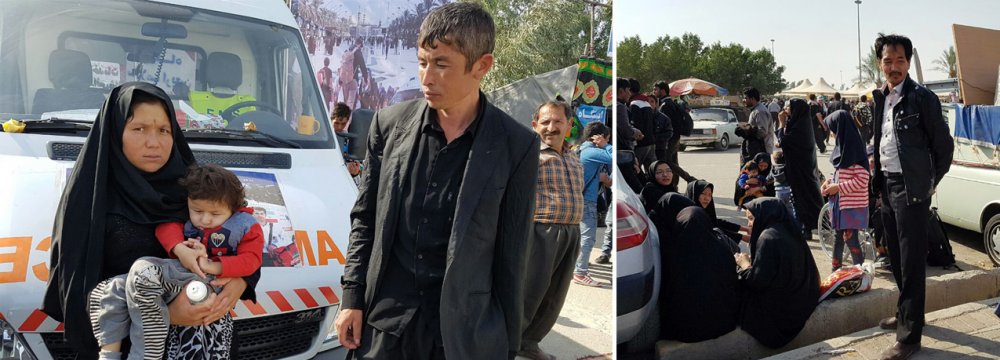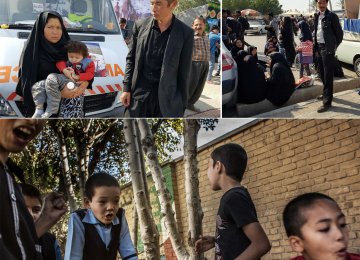Iran is one of the world’s four countries with the highest number of refugees. A recent report on the subject published by the Statistical Center of Iran (SCI) shows that the majority of the refugees come from Afghanistan, Iraq, and Pakistan.
Nearly 1.6 million registered Afghans are currently living in Iran among 1.63 million migrants, according to the latest round of National Population and Housing Census conducted from Oct. 2016-Feb. 2017.
Iran continues to host one of the largest and most protracted refugee populations in the world, despite the voluntary return of hundreds of thousands of Afghan (and Iraqi) refugees to their countries of origin over the past decade.
The SCI report indicates that the number of Afghan refugees officially registered in Iran is 1.58 million, followed by 34,532 Iraqis, and 14,320 Pakistanis. The 20,844 refugees from other nationalities include 713 from Turkey.
There is no exact and precise data available on the number of all Afghan refugees (legal and illegal) in Iran. According to the Interior Ministry statement in early 2016, almost 2.5 million Afghans resided in Iran of which only one million had proper documents and 450,000 had passports. An estimated one million refugees are living and working in Iran illegally.
The nationality of 105,060 people was ‘unknown’ as reported in the census, but the main populations of concern in Iran continue to be Afghans, the majority of whom arrived before 2001 as prima facie refugees.
Also, based on the numbers published on the SCI website (www.amar.org.ir), a large portion of the Afghans live in urban areas, with 1.24 million in cities, and 340,986 in rural regions.
Tehran Province hosts 515,567 or almost one third of the Afghan population in the country; Khorasan Razavi Province and Isfahan are next on the list with 219,442, and 183,124 Afghans respectively.
Kordestan Province in the western part with 18 Afghans hosts the smallest refugee population.
Globally, every minute 20 people or one in every 113 people, are forced to leave everything behind to escape war, persecution or terror in their homeland in the form of refugees, asylum seekers, internally displaced persons, stateless persons, or returnees.
Nearly half of the world’s refugees are children.
The majority of refugees in Iran, numbering 913,973 (56%) are in the 5-29 age group, and Afghan children aged 5-9 comprise the largest group with 196,592 in number. There are 562,352 aged 5-19.
Among the total Afghan refugee population, 845,267 are male and 738,712, female.
Iran is located in a region that remains home to one-third of the world’s refugees with over three million and a half people. Nearly, 70% of the refugees in the region are Afghans, the majority living and working in Iran (and Pakistan). Most Afghans fled to Iran either after the Soviet occupation of Afghanistan in 1979, or following the Afghan civil war in the 1990s and the US-led invasion in 2001.
Financial, Educational and Medical Support
The government in Tehran is the primary financial contributor to the refugee program through various ministries and organizations. Additional support is provided through semi-governmental organizations and charities. The government grants the refugee population access to: medical services, education for students, literacy classes for out of-school children and the labor market.
Iran’s Bureau for Aliens and Foreign Immigrants’ Affairs (BAFIA), which has the overall responsibility for coordinating refugee affairs in cooperation with other ministries, remains the United Nations High Commissioner for Refugees’ main partner in coordinating refugee affairs.
World Refugee Day, first observed in 2001, is held every year on June 20. On this day, tens of thousands of people around the world take time to recognize and applaud the contribution of forcibly displaced people throughout the world, according to the UNHCR.
The annual commemoration is marked by a variety of events in more than 100 countries, involving government officials, humanitarian aid workers, celebrities, civilians and the forcibly displaced themselves.
The goal is to raise awareness and funds to help relieve the suffering of the 60 million displaced people around the world, more than half of whom are children.
In September 2016, world leaders agreed to work towards a Global Compact for refugees in 2018 where all parts of society stand together with the social media hashtag #WithRefugees and do their fair share instead of leaving individual states to bear the burden of mass forced displacement.
The Global Compact asks governments to make sure every refugee child gets an education, every refugee family has somewhere safe to live, and every refugee can work or learn new skills to support their families.






Add new comment
Read our comment policy before posting your viewpoints